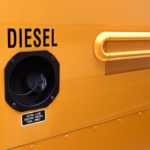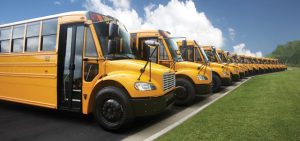 In previous articles, we have shown the degree to which diesel technology has cleaned up its act. As of 2010, all large (Type C & D) school buses are required to meet the same emissions standards. From a certification standpoint, clean-diesel emissions are 90 percent cleaner at the tailpipe than they were 10 years ago and just as clean – if not cleaner – than other fuel types. In fact, the benefits of clean diesel are clear when compared to the “hidden” costs associated with other alternative fuels.
In previous articles, we have shown the degree to which diesel technology has cleaned up its act. As of 2010, all large (Type C & D) school buses are required to meet the same emissions standards. From a certification standpoint, clean-diesel emissions are 90 percent cleaner at the tailpipe than they were 10 years ago and just as clean – if not cleaner – than other fuel types. In fact, the benefits of clean diesel are clear when compared to the “hidden” costs associated with other alternative fuels.
The choice is always greener?
The dominance of diesel fuel has not waned in the school bus industry. Despite a higher-than-ever focus on alternative fuel, the fact remains that 93 percent of today’s school buses run on diesel power. Still, with so much talk about alternate fuels today, districts running a diesel fleet are starting to feel pressure to switch to something cleaner and greener, if only just to keep up with the buzz of the industry.
While no single fuel is the best choice for all fleets, choosing the best alternative fuel for your fleet can be a daunting task. Luckily, for most districts, sticking with clean diesel may be the cleanest and best choice.
Comparing the Benefits of Clean Diesel & Alt Fuel “Hidden” Costs
With clean diesel leading the pack on emissions reduction, the best choice of alternative fuels often comes down to other factors, including fuel efficiency, safety, proven performance and durability, and total cost of ownership. A closer look at the benefits of clean diesel reveals a number of “hidden” costs associated with choosing a different fuel platform.
Clean Diesel is fuel-efficient.
Diesel remains the most fuel efficient engine in the market, providing up to 50% better fuel economy compared to other similar-size gasoline, propane or compressed natural gas engines. Of course, the numbers vary, based on usage, mileage, terrain and other factors but, with diesel’s overall low cost, efficiency, engine durability and resale value, diesel engines frequently have a total cost of ownership much lower than other alternative fuel-powered engines.
- More fueling events – Other alternative-fueled buses that use up to 50% more fuel require more fueling events. This is an additional labor cost that should be calculated and projected for the long-term when compared with clean diesel.
- Larger fuel tank options – Some alt fuel buses won’t allow you to completely fill the tank you have, regardless of tank size. Thomas offers an optional 100-gallon fuel tank on 54- and 66-passenger Saf-T-Liner C2 buses (standard equipment on 72-passenger Saf-T-Liner C2 buses.)
- Fueling Infrastructure Costs – The fueling infrastructure required with different fuel types should be calculated into your operating costs.
Clean Diesel is safe.
The flash point of a fuel is the lowest temperature at which a substance can form an ignitable mixture in the air. Among all fuels, diesel has the highest flash point at 165 degrees Fahrenheit. Compare that to the flash point of fuels such as propane, with a flashpoint of -150 degrees, and gasoline, with -45 degrees Fahrenheit.
Clean Diesel is proven.
 Not only has diesel been fueling the school bus industry for more than 20 years, but the vast majority of today’s school buses run on diesel power. Newer alternative fuel engines are upfitted and are not built for the medium- and heavy-duty/commercial grade market. Diesel engines are. In fact, diesel engines generally will last 15-20 years, while other engine platforms may need to be replaced multiple times during the normal lifecycle of a school bus.
Not only has diesel been fueling the school bus industry for more than 20 years, but the vast majority of today’s school buses run on diesel power. Newer alternative fuel engines are upfitted and are not built for the medium- and heavy-duty/commercial grade market. Diesel engines are. In fact, diesel engines generally will last 15-20 years, while other engine platforms may need to be replaced multiple times during the normal lifecycle of a school bus.
- Engine wear and tear – Upfitted alternative fuel engines turn faster RPMs and have to perform more work in the same time period than clean diesel engines. As a result they have never lasted as long in the past. An engine spinning 5200 times every minute versus 2600 times every minute will indicate a higher degree of wear and tear.
- Allison 2000 Transmission – Thomas clean diesel Saf-T-Liner C2 buses are equipped with Allison 2000 series transmission* versus Ford 6R140 transmission in other propane and gasoline fueled buses. Allison transmissions have been proven over many years as required to meet North Carolina state specifications. See this Allison Transmission brochure comparing the Allison 2000 & 3000 series to the Ford 6R140 transmission for durability and resale advantages.
*Note: ALL Thomas buses currently are equipped with Allison transmissions to meet the North Carolina state specification, regardless of fuel type.
Questions? Call us at
- Eastern North Carolina – Phil Loflin, Ext. 370
- Western North Carolina – Roy Parks, Ext. 378
 Skip to main content
Skip to main content